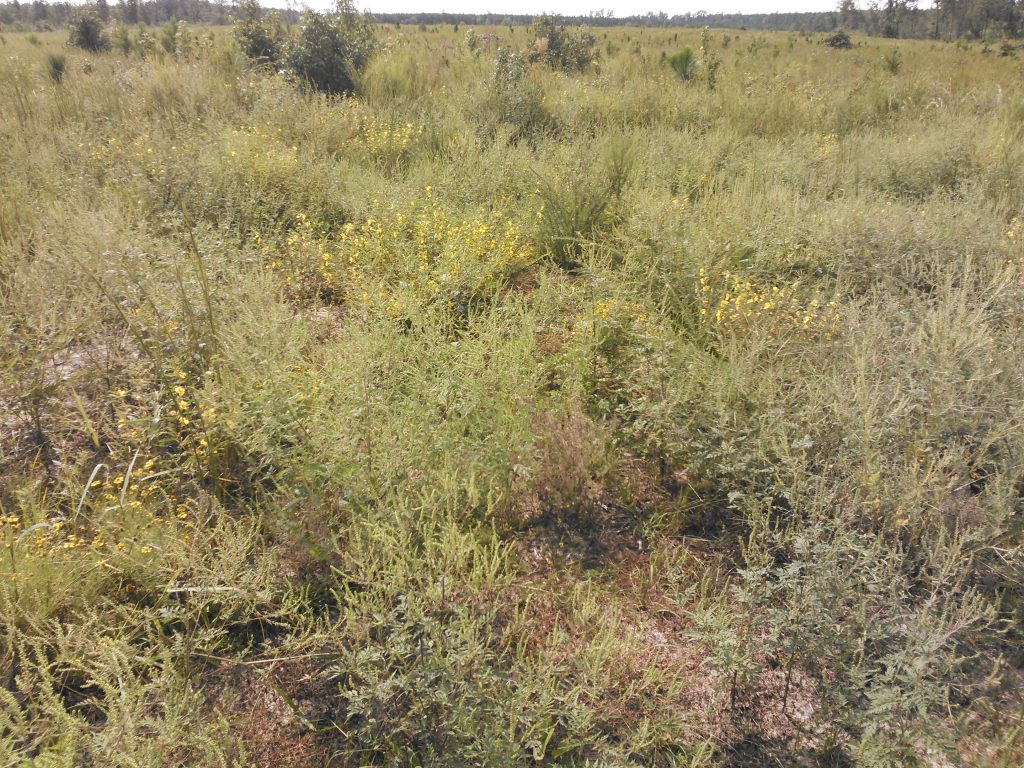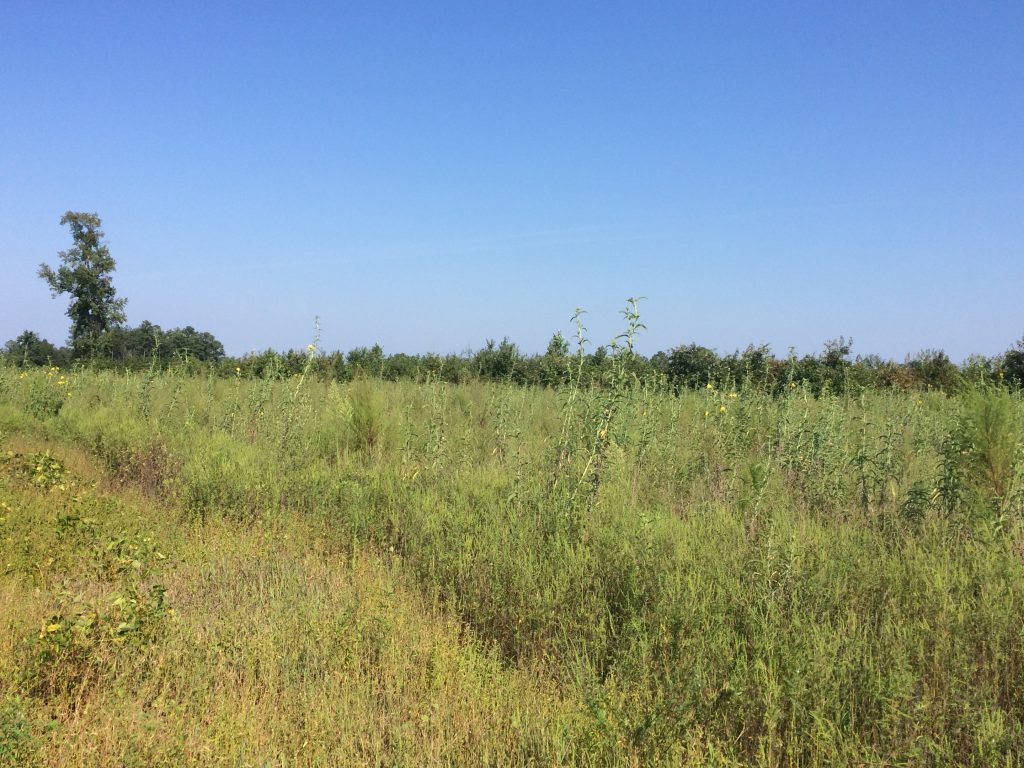
First, just a quick note to say our Department of Game and Inland Fisheries, which has had the word “game” in its name since 1916, as of July 1st became the Department of Wildlife Resources. Over the past several decades our mission has become more diverse, as has our constituency, and the time was right for a change – after all, we are now one fifth of the way through the 21st century. I look forward to serving Virginians just as diligently for the Department of Wildlife Resources in the future as I did for Game and Inland Fisheries over the past 24 years.
On to this month’s subject – quail brood-rearing habitat. It’s early July – the time of quail magic, when chestnut oak acorn-sized eggs, in small nests on the ground, having survived multiple days of egg laying (especially if you happened to be the first egg laid…as one egg a day is the general rule with clutches of 12 to 15 eggs common) and 23 days of incubation – by some miracle, as a bumble bee-sized quail chick packed inside that tiny capsule you managed to use your “egg tooth” and cut an almost perfectly circular hole out of the big end of your calcified coating, and leave it behind, now entering the domain of two-legged mobility. I suspect you were quite relieved to be out of that cramped encasement until you realized how miniscule you were amongst this land of giants. Luckily the Lord blessed you with an innate ability to move about and feed yourself only a matter of hours after your recent squiggling emergence.
You and your relatives occupy an amazingly broad geographic range – from Mexico to Wisconsin and south back through Florida. But there is little genetic difference between a bobwhite quail from just north of Abilene, Texas, to one just south of Farmville, Virginia. Which may be hard to believe given the arid habitat near Abilene consists of cat-claw acacia, mesquite, broom snakeweed, and western ragweed, to that near Farmville consisting of sumac, blackberry, partridge pea and eastern ragweed.
One area gets 15 inches of rain in a good year, the other 50. Did you say “ragweed” two times? Yes I did. Was that an accident? No it wasn’t. You see bobwhite quail throughout their entire range need a few basic things. They need a canopy of vegetation a few feet over their heads that provides shade and concealment from predators. They need those plants to be spaced apart at ground level – with stems being a few inches apart ideally to allow ease of movement, and they need some bare ground under there – 30% to 60% dirt under their feet and the poster plant for these conditions is ragweed. And they need access to some type of thickets for escape and loafing cover…and that’s about it.

Some biologists that are fussier than I am, add another component they refer to as a “bit grassier” nesting cover. Usually by the timing of management (disking, burning, cattle grazing) weedy brood-rearing cover, grassier nesting cover and escape thickets can be made to persist at about a 1/3 ratio on the landscape. Sounds simple enough. Quail managers refer to this as the “Thirds Rule” – 1/3 nesting cover, 1/3 brood-rearing cover and 1/3 thickets – plus or minus a few percentage points in any category.
If you manage in a rotational fashion in Virginia and you focus on brood-rearing cover and thickets, nesting cover will take care of itself. Brood-rearing cover here is created by soil disturbance of some kind, usually by the use of prescribed fire, or rotational disking, or both through time (cattle grazing if done correctly can also be effective). If you are not seeing much ragweed, you may not have the necessary brood-rearing cover. It’s not solely dependent on ragweed, but seeing ragweed, which is an annual that is dependent on it seeds falling on bare ground to persist, usually means the soil has been disturbed. Along with ragweed comes partridge pea, beggar-weed, tickseed sunflower, bee balm and more which produce the insects that quail chicks have to have to grow flight feathers and get strong quickly during their first critical weeks post-eggshell. In the arid west brood-rearing cover depends on rainfall, and when it is too dry, the weeds don’t come up, the insects are not produced and they have a quail population crash. In the east it’s too much rain that is our problem. If we do not disturb the ground every 2 to 3 years, the vegetation gets too thick and lush to support quail chick foraging.
So the ragweed (and its many weedy friends) that produces grasshoppers, beetles and larvae in abundance now, provides thousands of seeds that are more nutritious than corn on an ounce-for-ounce basis during December. If you have great brood-rearing cover, you will have great winter feeding cover. Now is the time to go out and evaluate your land for brood-rearing cover. It can consist of recently logged areas that have not yet been sprayed with herbicides, or have recovered from herbicides, multiple logging decks that are managed by disking during winter, open pine stands that have recently undergone burning, fallowed crop or food plot fields full of annual weeds, or rotationally grazed pastures that are allowed to go a little “wild” with weeds in places.
To create brood-rearing cover on your land, fallow some cropland and manage it by disking a third every year during the dormant season. Expand and improve your logging decks by heavy disking, then sowing with a cheap cover crop like millet. Manage them by disking a third of the decks during the dormant season every year. If ragweed does not appear on its own, plant it – the seed is readily available. Mix it with some legumes like partridge pea, beggar-weeds or native lespedezas like slender or round head, and plant during February. These decks can also be incorporated into a burning regime if within pine stands that are being burned. If planting food plots, consider leaving half of each fallow and weedy each year. This saves you time and money, and provides excellent brood-rearing cover for quail chicks and turkey poults.
Pasture and hay lands can be converted into brood-rearing habitat, but it takes a little more doing, a bit more planning and more time. We’ll take that up next month.


